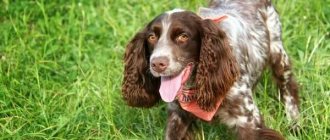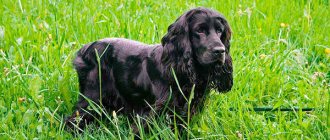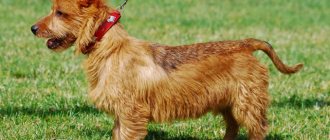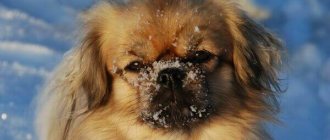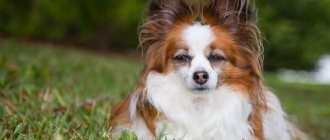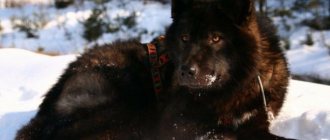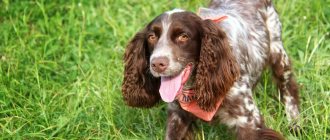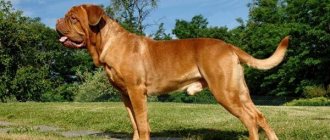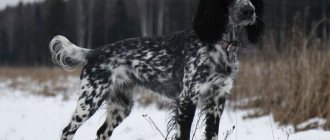Spaniels are the common name for a large group of breeds.
These include Cocker Spaniels, English Springer Spaniels, Sussex Spaniels, Cavalier King Charles Spaniels, German Wachtelhunds and other hunting dogs, as well as toy and toy dogs.
The Russian Spaniel is the only breed of gundog of domestic origin.
Distinguished by their innate hunting instincts and versatility, black spaniels can also be kept in a house or apartment simply as friendly, obedient and devoted pets to their owners.
Unlike many other breeds of spaniels, Russian hunting dogs are less trusting of strangers and therefore can be used for protection.
But when keeping them in the house, you need to take into account some breed characteristics.
Origin story and what it looks like in the photo
The first attempts to breed Russian spaniels were made back in the mid-1850s. But in those days the breed did not become widespread, and therefore the main stage of its formation began later - at the end of the 19th century.
The first spaniel brought to the territory of the Russian Empire was a black cocker , whose owner was Grand Duke Nikolai Nikolaevich, who was fond of hunting .
Later, other cocker and springer spaniels were brought to Russia, becoming the founders of a new domestic breed.
Systematic breeding of these dogs began in 1931.
Then a breed section was organized in the Blood Dog Breeding Section, so that by the end of the 1930s the domestic population of spaniels could not be classified as any of the other breeds, however, these were not yet dogs of the modern type.
During the Second World War, the population of Leningrad dogs, which had great breeding value, was almost completely destroyed. However, through the efforts of enthusiasts, the nascent breed was preserved and its development continued.
The original standard of the Russian Hunting Spaniel was developed in 1949 and adopted in 1951, but the breed, although recognized by the RKF, never received international official recognition.
In the 1960-1980s, Russian spaniels, including black ones, were very popular among domestic hunters. After all, thanks to their small size and unpretentiousness, these dogs could live both in a city apartment and in a house.
Around the same time, the fashion for hunting dogs began and Russian spaniels very quickly gained popularity not only as universal hunting dogs, but also as simply pets.
This popularity continues to this day, and, despite the fact that Russian spaniels are still not recognized by the FCI, they are becoming popular abroad..
Breed sections and clubs were organized in many CIS countries, as well as neighboring countries. And in 2002, the Russian Spaniel Club was created in the USA.
Possible diseases
Russian cocker spaniels are animals with a fairly strong immune system that protects well from diseases. But still they suffer from otitis media, obesity and food allergies. Although, provided that the owner takes proper care of the dog, such cases are close to a minimum.
But the dog is quite capable of catching an infection, because he is terribly curious, restless and a tireless researcher, penetrating into all corners. The risk increases even more if he is a regular participant in the hunt. Often dogs of this breed get sick:
- dermatomycosis (pathogenic fungi get on the skin and cause lichen);
- more serious fungal diseases such as aspergillosis or candidiasis (pathogenic microorganisms affect the respiratory system);
- piroplasmosis (caused by ixodid ticks);
- leptospirosis (due to swimming in stagnant water);
- toxoplasmosis (a single-celled parasite attacks the brain).
To reduce the risk of infection, before hunting, the pet is treated with special products and put on a flea and tick collar. And after returning home, they carefully examine, immediately removing any parasites found on the skin.
Marriage or breed?
Black color is considered standard for the Russian spaniel, as, indeed, are the coat colors derived from it.
Expert opinion
Kozhevin Semyon Kirillovich
Expert dog handler.
“The black Russian hunting spaniel, despite its relatively small size, is considered a universal hunting dog. It can be used for hunting forest, swamp, field and waterfowl, as well as brown hare and white hare. This dog is selflessly devoted to its owner, obedient, intelligent and affectionate to all family members. In everyday life, the Black Russian Spaniel is quite unpretentious, however, it needs long walks if kept indoors and proper coat care.”
English toy spaniel
- Height: from 23 to 28 cm
- Weight: from 3.5 to 6.5 kg
- Life expectancy: 12 to 14 years
- Temperament: affectionate, playful, gentle, mischievous, loving
This is the smallest spaniel, its small size makes it an ideal dog for city apartments. The gentle, cheerful and playful English Toy Spaniel originated in the Far East , and later appeared in England. These sweet and affectionate family companions enjoy playing with children and other pets.
Did you know that the English Toy Spaniel was a favorite of Queen Mary Stuart of Scotland? They say that he refused to leave his mistress even on the scaffold.
This compact breed with short legs and a small body has a long, shiny coat in four different colors. Its abundant coat is easy to maintain and only needs brushing once every two weeks.
Character traits
The Black Russian Spaniel is quite strong and resilient, it has a good sense of smell and persistence when searching for prey, and is an excellent swimmer and diver. Loyal to his owner, calm and obedient in a home environment.
He is smart and amenable to training, loves outdoor games and loves to take part in out-of-town trips.
She loves children and is not aggressive towards other pets . However, some males of this breed tend to dominate their peers.
Unlike most other spaniels, they can be quite distrustful of strangers, although they do not show malice towards them. Thanks to this, it is possible to use a black Russian spaniel as a guard.
This dog is very energetic and active and, in case of insufficient physical activity, can become hyperactive..
Boykin Spaniel
- Height: from 36 to 46 cm
- Weight: from 11 to 18 kg
- Life expectancy: 14 to 16 years
- Temperament: intelligent, friendly, energetic, impatient, sociable, easy to train
Boykin Spaniels, bred in South Carolina to hunt muddy river swamps , are naturally alert, brave and intelligent. These are excellent swimmers and field hunters. They have a characteristic liver or chocolate-colored fur with a thick undercoat.
Boykin Spaniels have recently gained popularity as family dogs due to their loyal, outgoing and friendly nature. They tend to get along well with their families and do things they enjoy. These pets learn quickly due to their intelligence and require a lot of daily exercise to stay fit and healthy.
Advantages and disadvantages
pros:
- A universal hunting dog, working equally well on various game birds and hares.
- Despite its small size, the black Russian spaniel is strong and resilient.
- It is persistent when chasing game and has a good sense of smell.
- Smart and well trained dog.
- It can be used not only as a working gun dog, but also as a pet and companion.
- Loyal to the owner, quite disciplined and obedient.
- He is good with pets and affectionate towards children.
- It can guard an apartment or house, although it is undesirable to further develop guard qualities in such a pet.
Minuses:
- Due to the fact that the Russian Hunting Spaniel is not recognized by the FCI, the Black Russian Spaniel will not be able to participate in major international exhibitions.
- May be overly distrustful of strangers.
- Too mobile, and with insufficient physical activity becomes hyperactive.
- Male Russian Spaniels sometimes try to dominate other dogs.
- Hunting instincts may cause your pet to unexpectedly chase a cat or bird while walking.
- Needs regular coat care.
Cavalier King Charles Spaniel
- Height: from 30 to 33 cm
- Weight: from 6 to 8.5 kg
- Life expectancy: 9 to 14 years
- Temperament: Playful, affectionate, fearless, sociable, patient, graceful, gentle, adaptable
Have you ever wondered why the Cavalier King Charles Spaniel is called that? This is because they were originally bred for the British nobility and had a rich heritage. You may have seen these dogs in famous paintings of the 16th-17th centuries. However, after the fall of the House of Stuart, the nobility distanced themselves from the breed, making the Cavalier King Charles Spaniel a rare breed.
Funny facial expressions and large, round, beady eyes are typical of this breed. Plus, their super silky hair comes in vibrant colors (enough to make you jealous!). four different color variations found in Cavalier King Charles Spaniels : white with chestnut markings (known as "Blenheim"), white with black markings, black with brown markings, and deep tan.
The Cavalier King Charles Spaniel breed is the perfect combination of the athleticism of standard spaniels and the calmness of toy breeds.
This breed only grows to 33 cm in height and is ideal for apartment living . Cavalier King Charles Spaniels love children and get along well with other pets, but will sometimes chase small animals such as guinea pigs and hamsters.
Dimensions, weight and other distinctive features
- Dimensions . Males - 38-44 cm, females - 36-42 cm.
- Weight. 15-20 kg regardless of gender.
- Frame . Slightly stretched, strong and slightly squat.
- Head . Dry and elongated, with a moderately wide skull and slightly convex forehead. The transition to the long and wide muzzle is well defined. When viewed from the side, the lip of a Black Russian Spaniel is shaped like a slightly rounded rectangle.
- Pigmentation of the nose, lips and eyelids . Black.
- Ears . Hanging, long, wide and rounded below, can be planted either slightly above or slightly below the eye line.
- Eyes . Oval in shape, preferably dark brown.
- Neck . Set quite low, moderately long and muscular.
- Rib cage . Well developed, moderately deep and wide.
- Back . Straight, moderately wide and strong.
- Belly . Moderately fit.
- Forelegs . Dry, straight and parallel, their length should be approximately half the height at the withers.
- Hind limbs . Set slightly wider than the forelegs, with well-defined joint angles and moderately short tibiae.
- Tail . With a well-defined dewlap, rather thick at the base, docked by about half, kept in line with the spine.
- Wool . Elongated, shiny, adjacent and soft, straight or slightly wavy. There are featherings on the ears, lower part of the body, limbs and tail.
- Color . Pure black, black and white, black and tan or tri-color with a predominance of black coat color.
Sussex Spaniel
- Height: from 33 to 38 cm
- Weight: from 16 to 20 kg
- Life expectancy: 12 to 15 years
- Temperament: cheerful, friendly, loyal, sociable, sociable, calm
If you enjoy hunting, hiking, or even long walks, the Sussex Spaniel is the perfect dog for you. Although this breed has a dark, serious expression, it is actually friendly and lively. The Sussex Spaniel has a balanced temperament and is gentle and affectionate with his family.
IMPORTANT! This breed is fiercely protective of its family and barks non-stop at any visitor. Before your neighbors start complaining about the constant barking, it is important to teach your pet the command “enough.”
Overall, Sussex Spaniels make great companions if you lead an active lifestyle and need a cute little friend to keep you company. These short-legged dogs have a massive, rectangular body with large, long ears and a thick coat that can be smooth or wavy.
Did you know that the Sussex Spaniel originated in the 18th century? The name of the breed is given in honor of Sussex, England, where the first Sussex Spaniel kennel was founded by Augustus Fuller.
Life expectancy and what diseases are they susceptible to?
Black Russian spaniels live 13-16 years, and dogs of this breed can be susceptible to the following ailments:
- Inflammation of the ears.
- Demodecosis.
- Allergy.
- Obesity.
- Blockage of the anal glands.
CAREFULLY!
A dog used as a gundog may be at increased risk of contracting infectious diseases, including those carried by ticks, which are abundant in forests and fields.
Therefore, the Russian spaniel needs timely vaccinations and preventive treatments against external and internal parasites.
Choosing a puppy
Spaniels are often used for police work
. Before purchasing a puppy, there are several factors to consider when choosing:
- Physical health. The dog must be absolutely healthy and active.
- Mental condition. You need to choose cheerful and friendly puppies.
- Compliance with standard. Before purchasing, you need to carefully examine the dog and make sure that it fully complies with the breed standard.
Basic rules of care
The coat should be brushed at least once a week. Once every 2-3 months the dog is given a bath and a haircut, which is best left to a professional. Between haircuts, you can trim your pet's fur yourself using regular scissors.
The Russian Spaniel's ears should be carefully examined after every hunt or walk . In this case, it is necessary to remove various debris, plant seeds and external parasites from their fur, if any are found.
The visible part of the ear canal should be cleaned with cotton swabs, and the inside of the ear with a damp cloth.
The eyes are examined daily and, if necessary, cleaned with a special product and a cotton pad.
Teeth can be cleaned with a dog toothbrush and toothpaste . You can also give your pet treats or toys designed to clean them to prevent tartar.
Nails are trimmed with a nail clipper if they grow long enough and do not wear down on their own during walks.
Irish Water Spaniel
- Height: from 53 to 61 cm
- Weight: from 20 to 30 kg
- Life expectancy: 10 to 12 years
- Temperament: smart, mischievous, inquisitive, alert, fast, active
Irish Water Spaniels are water retrievers that are generally energetic, fun-loving, and intelligent. They learn very quickly and obedience training is a cakewalk with them. However, this active and energetic companion is not intended for novice dog owners , as it can be stubborn and overly mischievous.
Trying to play with these little dogs when they're not in the mood is a real challenge.
These dogs are excellent swimmers and fiercely guard the home, barking only to alert the family to any danger.
Irish Water Spaniels typically have thick, curly hair on their bodies, making them almost identical to Poodles. Their hypoallergenic coat looks best with occasional brushing and trimming.
How to feed?
You can feed your Black Russian Spaniel both ready-made food and food prepared at home . The first feeding option is preferable for dogs used for hunting, as this is the easiest way to quickly feed a pet in a field or forest.
At the same time, the food must be of high quality and suitable for the spaniel in size, health, age and activity.
If the dog eats natural food, a significant part of its diet should be meat . You should add some vegetables, porridge, fermented milk products, as well as vitamins and mineral supplements to it.
NOTE!
Russian hunting spaniels are prone to overeating: they will ask for more even if they have just eaten a hearty meal.
Therefore, you should not give your pet more food than is necessary in accordance with the nutritional norm for him.
Nutrition
Premium dry food (or super-premium) is an ideal product for a representative of the breed in question. It contains all the nutritional components that an adult dog’s body needs. Also on store shelves you can see special commercial diets for hunting breeds.
English Cocker Spaniel puppies need to eat differently. They should go to the bowl at least 3-5 times a day. It needs to be filled with meat, cottage cheese, milk and soups alternately. When laying the foundation for a baby's health, it is important to ensure that his body receives minerals, vitamins and amino acids. Sample menu for a cocker puppy:
| Meals, number in order | Food, drinks |
| 1 | Raw meat, water |
| 2 | Cottage cheese or chicken broth |
| 3 | Buckwheat porridge with butter, water |
| 4 | Bread, steamed vegetables, water |
| 5 | Milk, fruit |
You should not overfeed your pet to prevent it from becoming fat. Also make sure that household members do not give him food from the table, because in this case an allergen may enter his stomach and provoke an adverse reaction in the body.
Foods prohibited for spaniels:
- Honey.
- Chocolate.
- Bones of birds and animals.
- Sweet pastries.
- Fish with bones.
- Spicy dishes.
- Smoked meats.
How to choose?
Even if the future pet is not planned to participate in exhibitions and breeding, you only need to buy a black Russian spaniel with documents.
To do this, it would be best to contact a specialized kennel or a kennel club.
And if a dog is bought for hunting, it would be a good idea to ask the breeder whether the parents of the puppies have field testing diplomas.
When choosing a puppy from a litter, you need to pay attention to its appearance. He should not have inflamed skin, watery eyes, dirty ears or nasal discharge.
A good puppy's coat is quite soft, shiny and silky . The baby himself looks quite well-fed, but not overly well-fed; he has a regular topline and strong, parallel limbs.
A healthy black Russian spaniel puppy is quite active and playful, he is moderately curious, willingly approaches people, without showing aggression or cowardice..
Price of a dog
In Russia, buying a purebred puppy from good parents is not so difficult. This is usually done through the National Club. The main thing is to choose trusted breeders, about whom there are only positive reviews. When choosing a puppy, focus on its color, shiny coat, and healthy appearance. A healthy cub is cheerful and active, but may be suspicious of strangers. The price for a four-legged friend with a pedigree will start from twenty thousand rubles .

